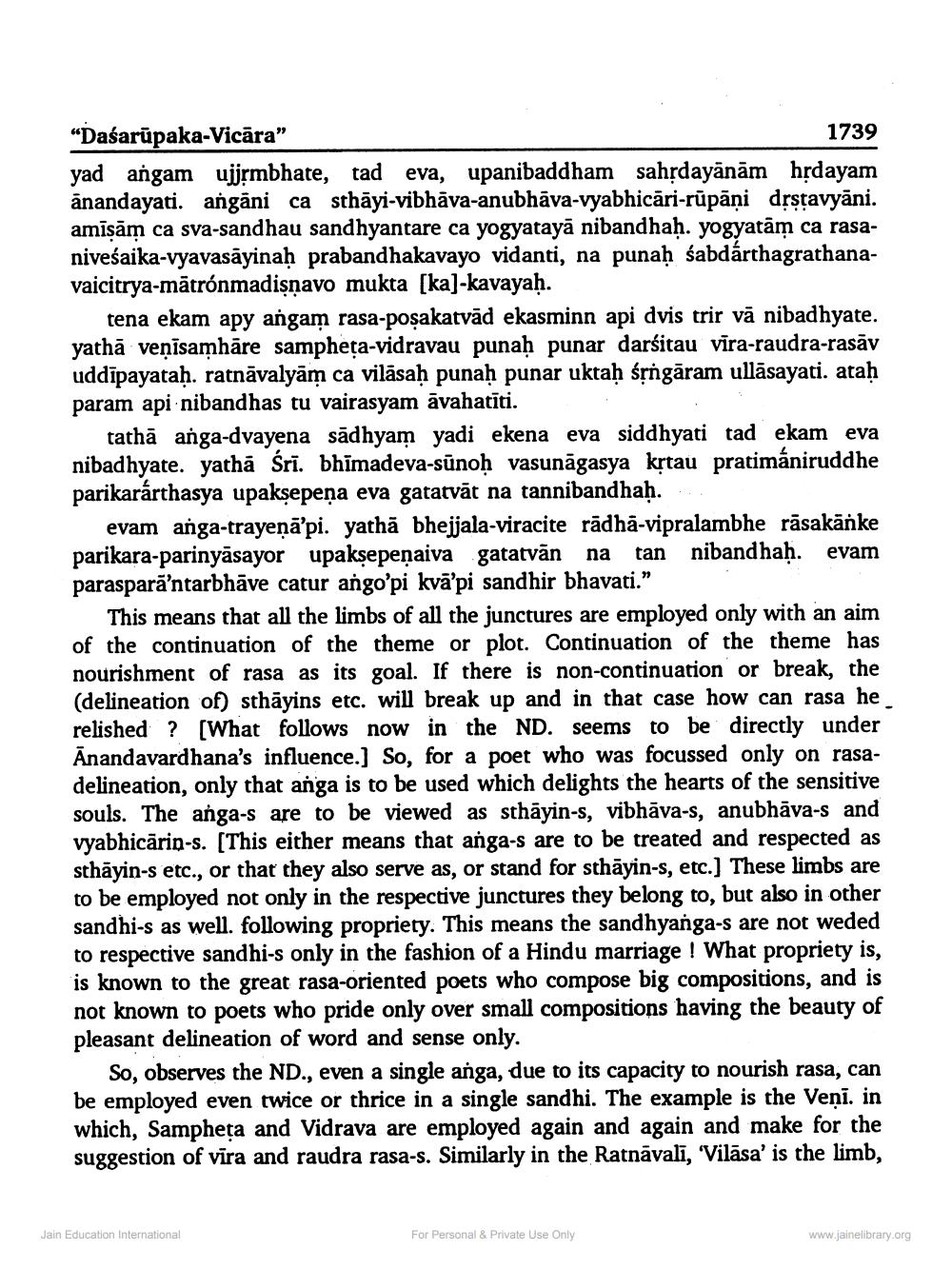________________
"Dasarūpaka-Vicāra"
1739 yad angam uijsmbhate, tad eva, upanibaddham sahrdayānām hrdayam ānandayati. angāni ca sthāyi-vibhāva-anubhāva-vyabhicāri-rūpāņi drstavyāni. amīsām ca sva-sandhau sandhyantare ca yogyatayā nibandhaḥ. yogyatām ca rasaniveśaika-vyavasāyinah prabandhakavayo vidanti, na punah sabdárthagrathanavaicitrya-mātrónmadişnavo mukta [ka]-kavayaḥ.
tena ekam apy angam rasa-poșakatvād ekasminn api dvis trir vā nibadhyate. yathā venisamhāre sampheta-vidravau punah punar darsitau vira-raudra-rasāv uddīpayatah. ratnāvalyām ca vilāsah punaḥ punar ukraḥ śrngāram ullāsayati. atah param api nibandhas tu vairasyam āvahatīti.
tathā anga-dvayena sādhyam yadi ekena eva siddhyati tad ekam eva nibadhyate. yatha Śrī. bhimadeva-sūnoh vasunāgasya krtau pratimániruddhe parikarárthasya upakṣepeņa eva gatarvāt na tannibandhaḥ.
evam anga-trayenā'pi. yathā bhejjala-viracite rādha-vipralambhe rāsakānke parikara-parinyāsayor upaksepenaiva gatatvān na tan nibandhah. evam parasparā’ntarbhāve catur ango’pi kvā'pi sandhir bhavati.”
This means that all the limbs of all the junctures are employed only with an aim of the continuation of the theme or plot. Continuation of the theme has nourishment of rasa as its goal. If there is non-continuation or break, the (delineation of) sthāyins etc. will break up and in that case how can rasa he relished ? [What follows now in the ND. seems to be directly under Anandavardhana's influence.) So, for a poet who was focussed only on rasadelineation, only that anga is to be used which delights the hearts of the sensitive souls. The anga-s are to be viewed as sthāyin-s, vibhāva-s, anubhāva-s and vyabhicārin-s. (This either means that anga-s are to be treated and respected as sthāyin-s etc., or that they also serve as, or stand for sthāyin-s, etc.) These limbs are to be employed not only in the respective junctures they belong to, but also in other sandhi-s as well. following propriety. This means the sandhyanga-s are not weded to respective sandhi-s only in the fashion of a Hindu marriage ! What propriety is, is known to the great rasa-oriented poets who compose big compositions, and is not known to poets who pride only over small compositions having the beauty of pleasant delineation of word and sense only.
So, observes the ND., even a single anga, due to its capacity to nourish rasa, can be employed even twice or thrice in a single sandhi. The example is the Veni. in which, Sampheta and Vidrava are employed again and again and make for the suggestion of vīra and raudra rasa-s. Similarly in the Ratnāvalī, 'Vilāsa' is the limb,
Jain Education International
For Personal & Private Use Only
www.jainelibrary.org




